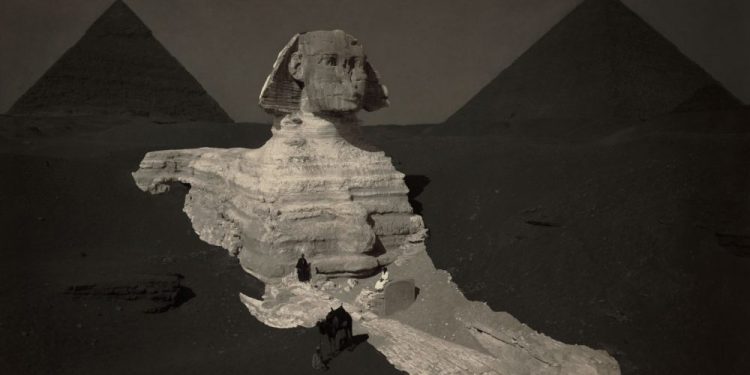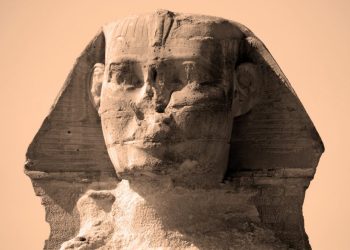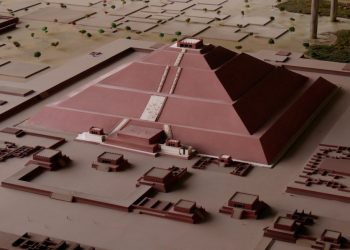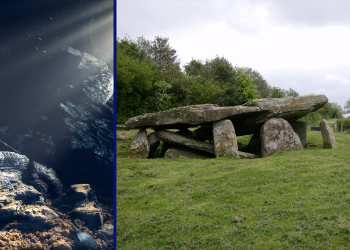Although the pyramids of Egypt are their greatest tourist attraction, the land of Pharaohs has much more to offer. From mesmerizing temples to massive obelisks reaching for the stars, Egypt is a land of incredible history. In addition to the pyramids, there’s one specific monument that’s unlike any other: the Great Sphinx of Giza, and it is Egypt’s ancient treasure.
The Great Sphinx was not built as some people believe but carved and sculpted from a limestone block at the Giza plateau. It has a height of about 20 meters and measures around 70 meters in length.
The head is said to represent the pharaoh Khafre, having the body of a lion. In ancient times it was painted in bright colors: its body was likely painted in reddish tones, and the nemes, the part that covered the head of the Sphinx was painted yellow and blue stripes.
Khafre, is that you?
Whether the Sphinx represents Khufu remains a mystery. Mainstream Egyptologists usually agree it was commissioned by King Khafre of the Fourth Dynasty, the man who is also said to have ordered the construction of the second-largest pyramid at Giza.
Whether this is the case, we can’t possibly know, not unless we have a time machine that allows us to travel back to the Fourth Dynasty, around 4,400 years ago, and see for ourselves.
That’s because even though the Sphinx is the most unique single stone monument in Egypt, no references of the statue exist dating back to the alleged period, it was carved in. In fact, everything we have written down about the Sphinx, and whatever can be traced back to ancient Egypt, was penned down thousands of years after the Sphinx was carved. Archeologists have still not discovered any sort of papyri or symbols that describe the Sphinx or that mention, Khafre commissioning it.
Standing guard in front of the pyramids, the massive monument faces West to East. It is one of the largest and oldest statues on the planet. Unlike the pyramids in Egypt, which were built across generations where pharaohs tried replicating the achievements of their predecessors, there’s only one Great Sphinx. Nonetheless, other Sphinx statues have been found in Egypt, but they are nowhere near as large as Giza’s.
We call it the Sphinx. But thousands of years ago, its creators had a different name for it. That name is forever lost to history since the people who caved it left no evidence of it. The name by which the statue goes today was given to it in classical antiquity, approximately 2,000 years after mainstream scholars believe it was carved.
Strangely, and even though it was one of the most important monuments in Egyptian history, there are no known inscriptions of the Sphinx in the Old Kingdom, nor are there any mentions of the Sphinx ever being carved.
This is strange because the ancient Egyptians were meticulous scientists and excellent record keepers. During the New Kingdom, the Sphinx became known as Hor-em-akhet, the solar deity.
Circumstantial evidence at best
In the last few decades, mainstream Egyptologists believe the Sphinx is no older than the Fourth Dynasty despite conflicting evidence and different opinions. But this is based on archeological guesswork and not much physical proof, besides the belief system of certain Egyptologists.
Selim Hassan, an expert on the Sphinx and a researcher who spent many years excavating the ancient monument and its surroundings, sums up the problem concerning the Sphinx in his book “The Sphinx: Its history in the light of recent excavations.”
Hassan wrote:
Taking all things into consideration, it seems that we must give the credit of erecting this, the world’s most wonderful statue, to Khafre, but always with this reservation: that there is not one single contemporary inscription which connects the Sphinx with Khafre; so, sound as it may appear, we must treat the evidence as circumstantial, until such time as a lucky turn of the spade of the excavator will reveal to the world a definite reference to the erection of the Sphinx.
What early Egyptologists said
But although mainstream experts seem convinced about the Sphinx’s’ identity, early Egyptologists who studied the Sphinx back in the 1800s were of a different point of view. By analyzing the surrounding temples and interpreting the evidence, Sir Flinders Petrie—for one—said that the temples surrounding the Sphinx, and by extension the Great Sphinx, date back further in history than the Fourth Dynasty.
Petrie wrote:
“The date of the Granite Temple [Valley Temple] has been so positively asserted to be earlier than the fourth dynasty, that it may seem rash to dispute the point.”
Petrie was an expert in ancient Egypt, and he was considered one of the leading academics in the field.
The Spinx spent several centuries buried beneath the Sphinx, waiting for time to pass until someone finally released it from its sleep. Auguste Mariette unearthed the Inventory Stella, which tells how Khufu discovered the Sphinx already buried in Sand. The inventory stela has been dubbed a purposeful fake created in ancient times. But it is physical evidence that tells us that the Sphinx predates Khafre. Mainstream experts disregard this.
In 1886, Gaston Maspero, another leading expert in Egyptology was surveying the area around the Sphinx. And based on what he had found at the time, he too concluded that the Sphinx must predate the Fourth Dynasty reign and was carved much earlier. Maspero believed that the Sphinx was Egypt’s most ancient monument.
Another Egyptologist and expert in the field, E. A. Wallis Budge, shared his colleagues’ views on the Sphinx and how it predates the reign of Khafre. In his 1914 book The Gods of the Egyptians, Wallis Budge explained his view about the age of the Sphinx.
“This marvelous object [the Great Sphinx] was in existence in the days of Khafre, or Khephren, and it is probable that it is a very great deal older than his reign and that it dates from the end of the archaic period around 2686 BC.”
The above are just some of the many examples of what early Egyptologists thought about the Sphinx’s age. Many contemporary experts and writers still share their views, although opposed by strict opinions set forth by mainstream experts.
No ancient sources mentioning the Great Sphinx
Although the Egyptians were excellent record keepers, there are no hieroglyphics, symbols, or illustrations of the Sphinx dating back to the Fourth Dynasty reign of Khafre. Nothing discovered to date, written on papyri or recorded in another way by the ancient Egyptians tells us conclusively that it was Khafre who carved the Sphinx.
Saying that the face of the Sphinx is reminiscent of Khafre is an additional mistake since we can’t possibly say that one statue looks like another statue, and represents a man who lived 4,400 years ago without knowing for certain what that man looked like.
If there are no sources of the time when mainstream experts say the Sphinx was carved, why do we have to believe the Sphinx was carved in the time of Khafre? Well, we don’t.
Since no physical evidence exists that conclusively puts the Sphinx’s origin to the time of Khafre, for all we know, the Sphinx could predate the Egyptian civilization. I am not saying it does. Petrie and Maspero believed the Sphinx could predate Khafre and possibly the entire Fourth Dynasty, and for all we know, it just might. So if it has been conclusively proven that the Sphinx represents Kahfre, why is it so difficult to accept the possibility that it predates the Fourth Generation?
In the same way, the Sphinx could have been carved after Khafre and perhaps even Menkaure, but given the location of the Sphinx and its vicinity to Khafre’s Temples, mainstream scholars say this isn’t a possibility. Again, this is just circumstantial evidence.
Although not as accepted as mainstream experts set forth, one theory comes from Graham Hancock and Robert Bauval, two researchers who placed the construction of the Great Sphinx based on the location of Stars around 10,500 BC.
Is it possible that there are no records of the Sphinx dating from the reign of Khafre because the monument predates the King? Certainly so. Is it conclusive evidence? Definitely not.
Join the discussion and participate in awesome giveaways in our mobile Telegram group. Join Curiosmos on Telegram Today. t.me/Curiosmos











